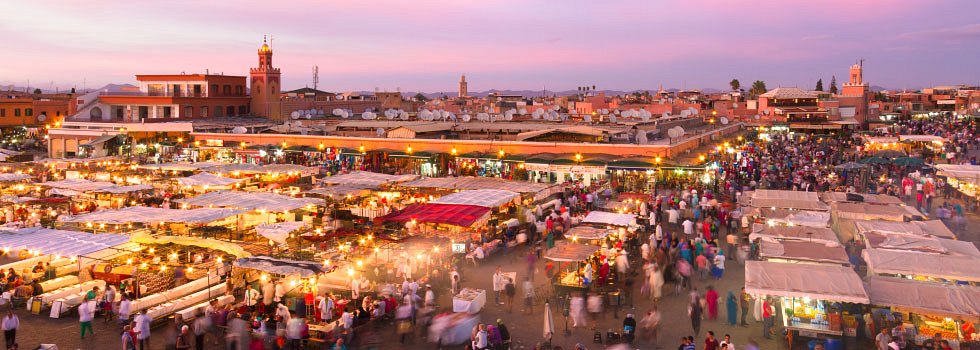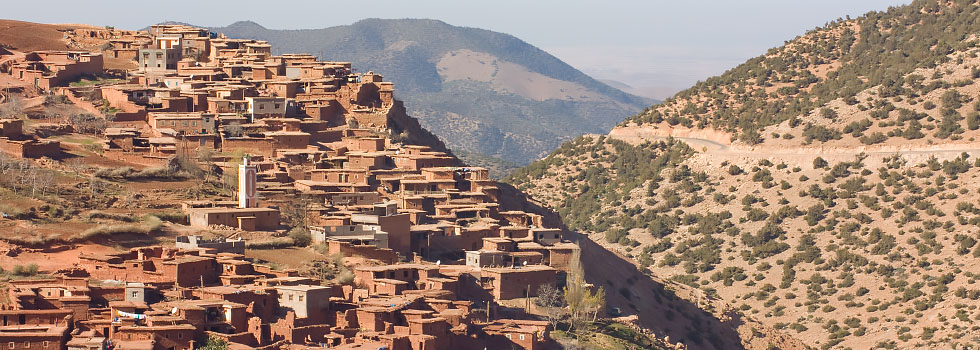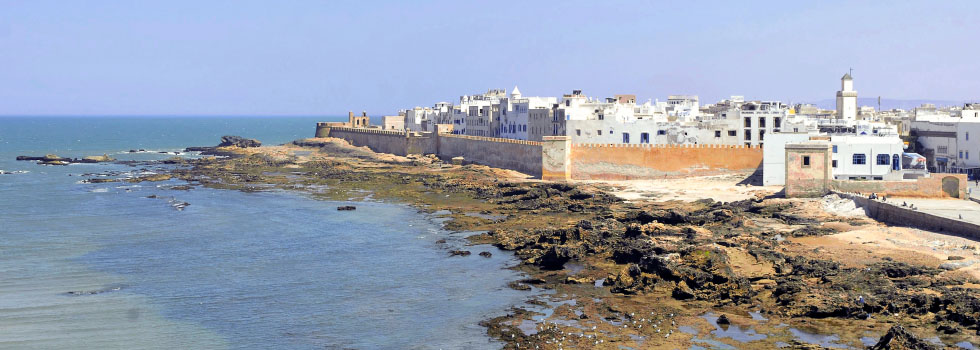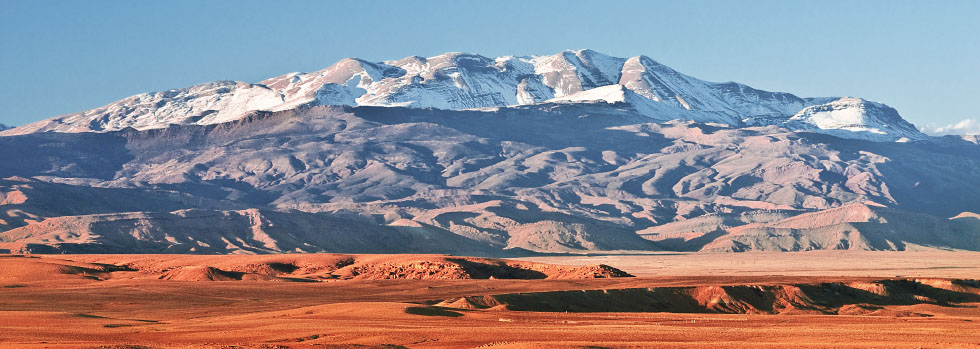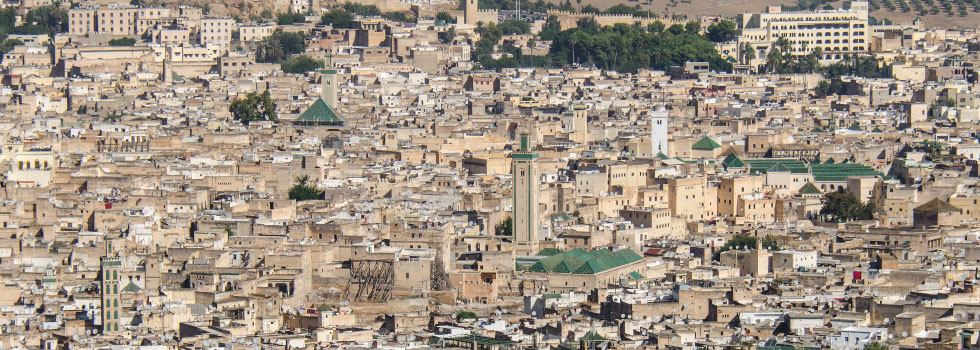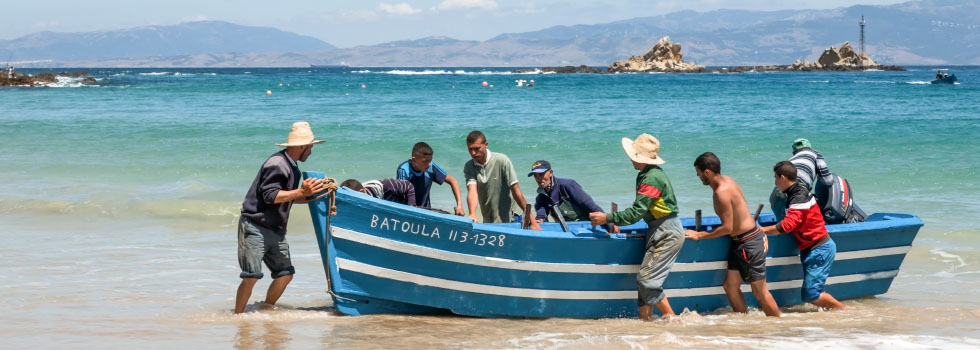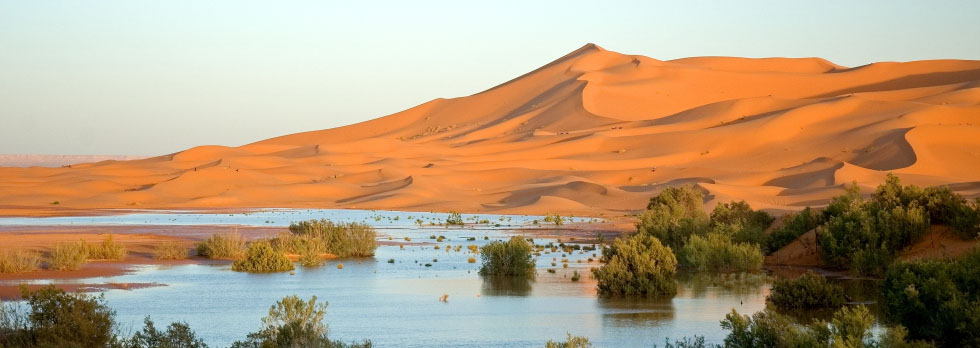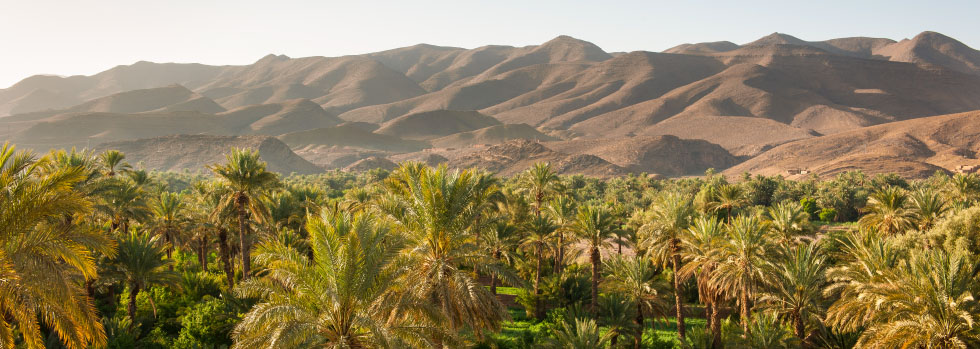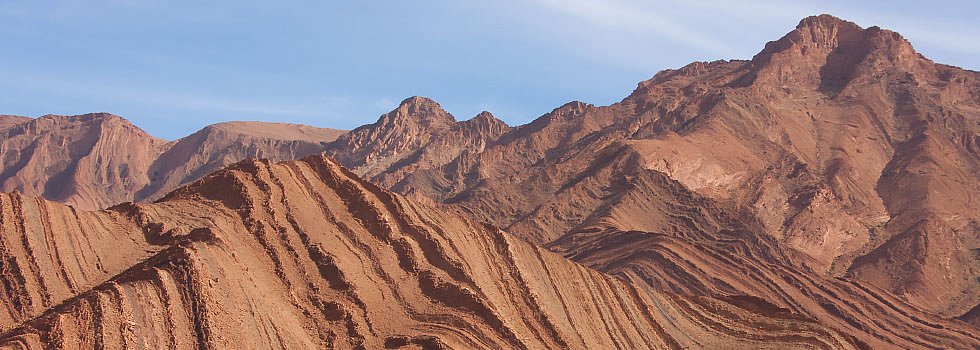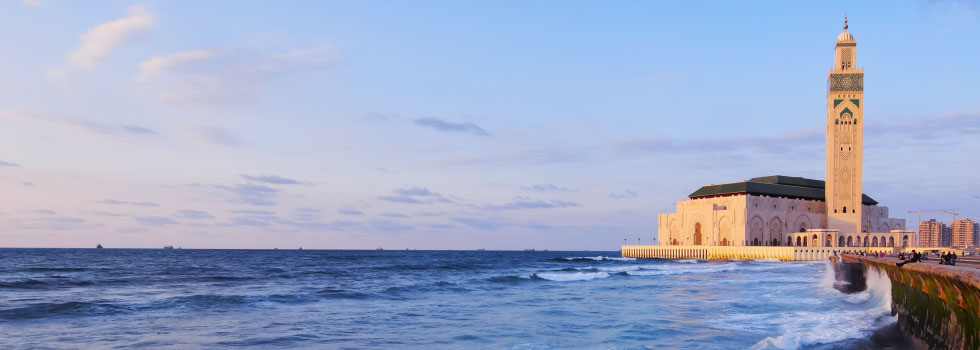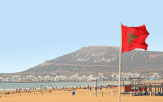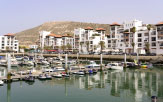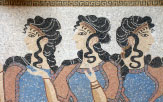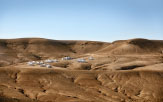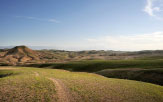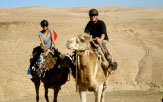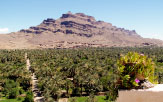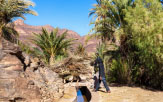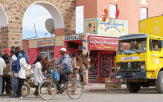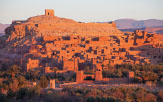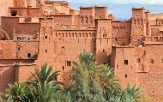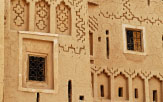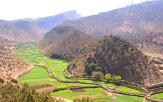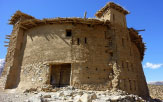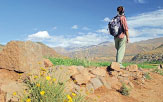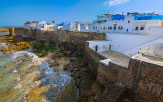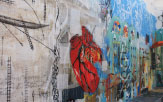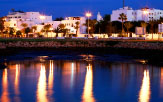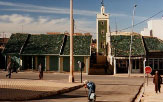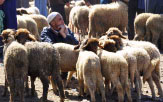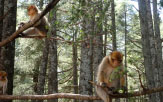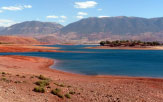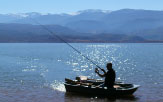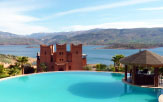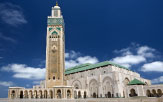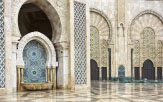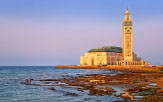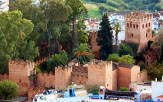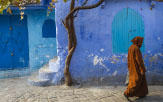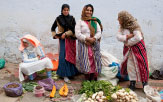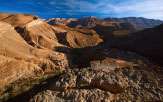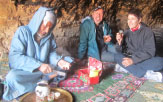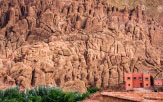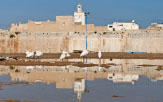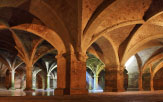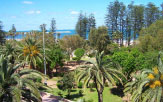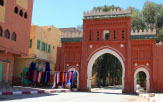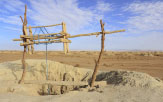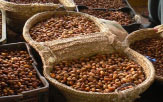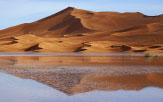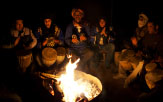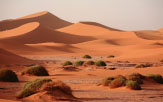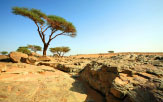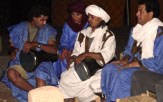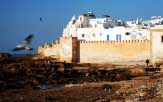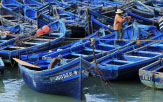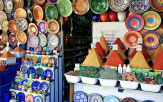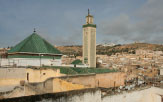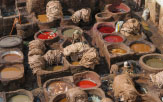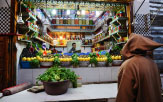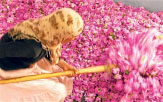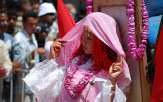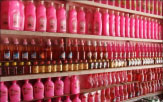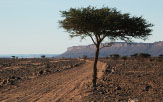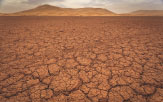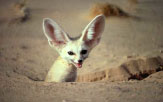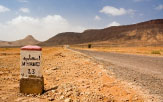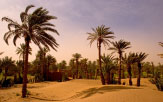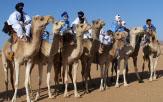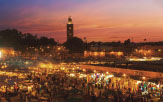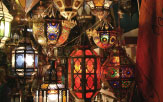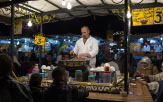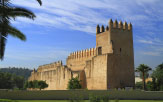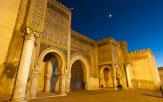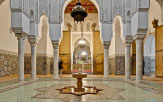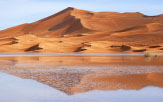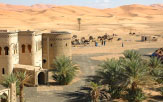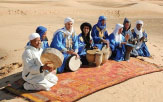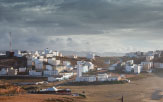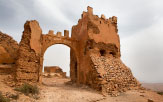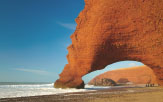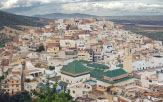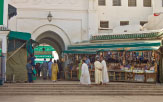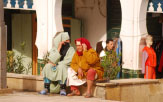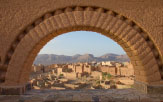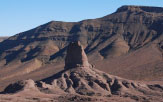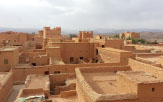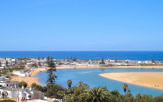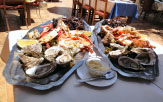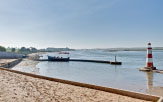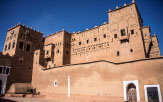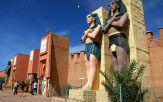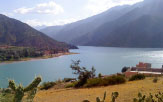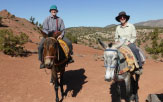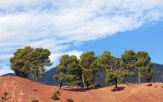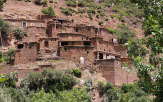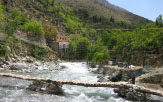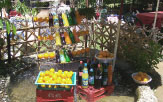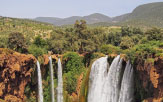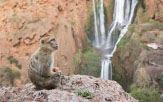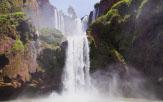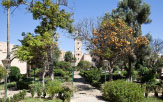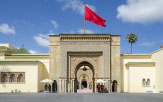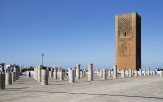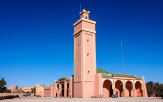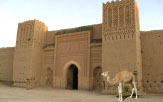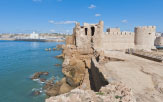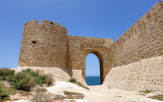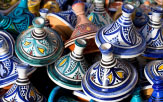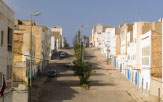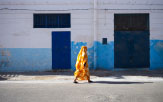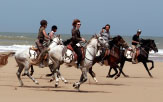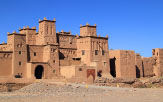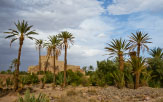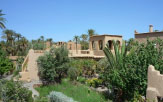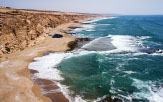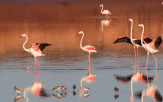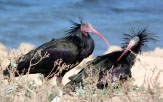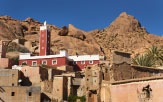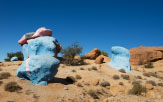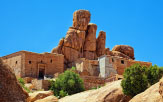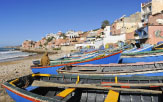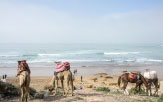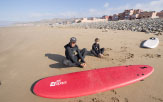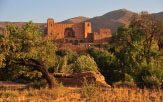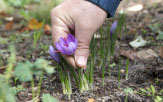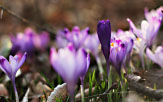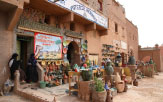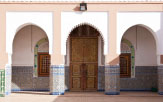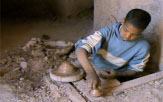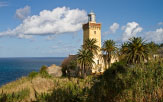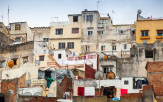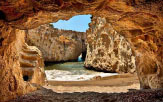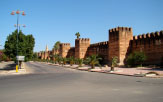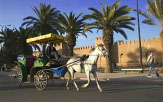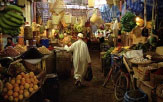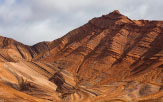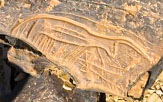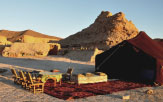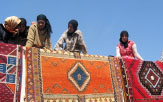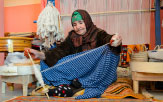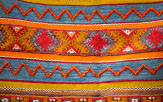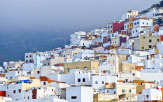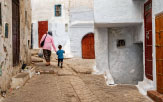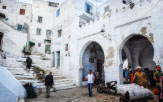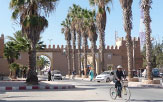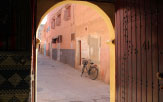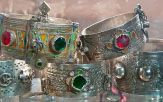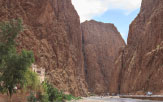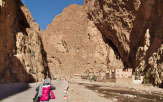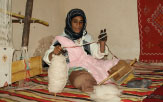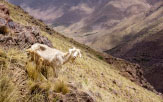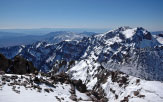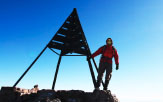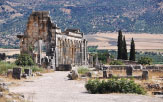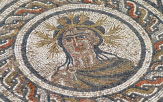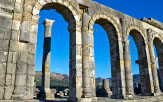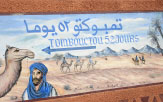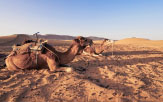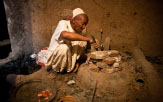Destinations
The Kingdom of Morocco offers a cornucopia of fascinating sights, historic medieval medinas, seaside havens, hidden kasbahs, mountain villages and modern cosmopolitan cities. On this page we list some of the most important Moroccan cities, towns, villages and locations that we include in our Morocco adventure holidays and tours. It is an A–Z of key places of interest that we think are worth spending anything from a few hours to a few days to explore. Where a destination is listed in a Tour Itinerary, this means you will at least make a stop here to visit the main sights even if not spending a full day or two here. Extra time in any destination in the Kingdom of Morocco (even those not on our list) can be added upon request.
Agadir
Click small photos to enlarge
Agadir, on Morocco’s Atlantic Coast, is the country’s prime seaside resort and features in several of our itineraries. It is approximately 3 hours west of Marrakech and 4 hours south of Essaouira. High-end hotels and all-inclusive resorts are stretched along a sweep of golden sand, topped with a new marina at the northern end. Agadir has everything for fans of sun, sea, sand, golf and nightlife, suiting families, couples and singles. However, it is also a bustling market town and the gateway to Morocco’s Deep South as well as the fertile Souss Plains and the Souss-Massa Nature Reserve. Once you are away from the main beach, the area around Agadir features some of Morocco’s most beautiful and most deserted coastline—great for surfers and nature lovers. Apart from the splendid beach promenade, other attractions include the Museum of Amazigh Culture, the hilltop Kasbah overlooking the bay, the new marina district, the Valley of Birds mini-zoo and the Agadir Medina handicrafts space. The old city of Agadir was largely destroyed by an earthquake in 1960, hence there are few ‘old’ Moroccan neighbourhoods left and all modern hotels and apartments have been built to resist future seismic activity. Because of its tourism focus, many charter and budget airlines use Agadir airport, making it a great start or finish point for your Morocco adventure tour with SheherazadVentures. Accommodations we use in Agadir are boutique small hotels to the south of the main resort, or alternatively a beachfront 4-star modern hotel property.
Add-on activities we can arrange In the Agadir area include: Golf; Hammam/Spa; Horse riding; Quad biking; hiking; Surfing & watersports.
Agafay Desert
Click small photos to enlarge
Around 40 km from Marrakech, the Agafay Desert offers a great opportunity to experience a day or a night in the desert for those who don’t have the time or the itinerary to visit the great Sahara. Rather than a typical sandy desert of dunes, the Agafay desert is a sun-baked, undulating, stony plateau with a few small earth-built villages and smallholdings. The best time to visit is spring and autumn when the climate is very pleasant and there are wild flowers, prickly pear cacti, eucalyptus, olive trees, oleander and shimmering grasslands set against the Atlas Mountains backdrop. We offer day tours to the Agafay Desert but we can also arrange accommodation in a splendid luxury bivouac camp or stylish retreat.
Add-on Activities we can arrange in the Agafay desert include: Camel trekking; Horse riding; Hiking and walking; Hot-air balloon rides; Quad biking.
Agdz
Click small photos to enlarge
At the base of Jbel Kissane, a mountain said to resemble upturned tea glasses, and along the shores of the Draa River, the market town of Agdz once enjoyed a key position on the route of the camel trains which crossed the Sahara and brought goods to trade and export in the ports of Agadir and Essaouira. It is still is a key agricultural and date-cultivation hub of the Draa Valley oasis, on the main route between Ouarzazate and Zagora. Agdz is included in many of our Southern Valleys and Oases tours as you head towards the Sahara at Erg Chigaga. It is worth a visit in order to see its impressive palmeraie (date palm oasis) interspersed with traditional mud-brick homes and kasbahs, including the oldest in the region, the 16th century Kasbah des Caids at Tamnougalt. The route along the Draa is one of the most beautiful road-trips in Morocco, passing villages, palm trees, small gardens full of henna, wheat and vegetables, crumbling rust-red kasbahs and fortified villages, mosques and daily scenes of agricultural life unchanged for centuries. A great time to come is in October/November during the date harvest when the oasis is bristling with activity. The area can be explored at close quarters in a 4x4 to take you away from the main national road and into the small villages or ksour. We offer character accommodation in Agdz in either a luxury boutique guesthouse or a simpler, converted traditional Kasbah.
Add-on activities that we can arrange in Agdz include: Hiking and walking; Off-road cycling.
Ait Benhaddou
Click small photos to enlarge
Ait Benhaddou is an impressive hilltop kasbah reached by crossing the Oued Mellah river, 30 km north of Ouarzazate. On the southern side of the High Atlas Mountains it is approximately 4 hours drive from Marrakech. It is probably the best example of earth-packed buildings in a kasbah settlement in Morocco and is a key feature on our Southern Valleys and Oases tours as well as our Sahara Desert tours. You may not realise it, but you have probably seen the UNESCO World Heritage site of the Kasbah at Ait Benhaddou several times before—it has featured in many Hollywood films—often doubling as ancient Rome or the Biblical Lands in movies such as Gladiator, Prince of Persia, Jewel in the Nile and Lawrence of Arabia. This is the most famous kasbah in Morocco—a fortified hilltop village which once controlled the trade caravans that passed through from sub-Saharan Africa. The Kasbah, which is inhabited by just a few local families, has been recently restored and is a splendid example of the traditional architecture of southern Morocco with crenelated towers decorated with carved Berber motifs. Typically, you will have lunch in one of the restaurants overlooking the kasbah and then enjoy a walking tour into the narrow streets of the old kasbah to admire the views across the surrounding landscape from the grain-store at the very top of the fortifications. We offer accommodation in a number of small boutique guesthouses or converted Kasbah-style hotels in the immediate area to allow for a more leisurely exploration. We also offer Day Tours from Ouarzazate and Marrakech which include visiting the Kasbah at Ait Benhaddou.
Add-on activities that we can arrange in Ait Benhaddou include: Hiking and walking; Quad biking.
Ait Bougemez Valley
Click small photos to enlarge
Around 5 hours north east from Marrakech in the Central High Atlas Mountains, the area known as Morocco’s ‘Happy Valley’, was cut off for several months of the year by snow until a paved road was laid to connect it to the regional centre, Azilal, in the early 2000s. The valley—a plateau at 2000 m—is 14 kilometres long and around a kilometre wide. It is a lush, flat expanse of fruit and nut orchards, fields of barley and corn, and green pastures criss-crossed by flowing streams. As such, it is a haven of peace and tranquillity surrounded by mountains - great for trekkers and climbers but also for those who prefer gentler walking and exploring. On a pyramidal peak overlooking the valley is the UNESCO-registered shrine to Sidi Moussa, with its granary and museum, where the guardian is said to be anything between 70–120 years old! From here, you get magnificent views of the valley and the surrounding peaks (including Irhil M’Goun, Morocco’s 2nd highest mountain at 4068m). In the valley, you can visit Berber villages of mud-built houses to get a glimpse of local life, seeing the women washing clothes in the stream with their the kids playing close by under the walnut trees. The accommodation we use here is a simple rustic eco-lodge built using traditional materials and serves as an ideal trekking base. You’ll find Ait Bougemez in our Complete Atlas Mountains Explorer tour which is ideal for families.
Add-on activities that we can arrange in Ait Bougemez Valley include: Hiking and walking; Mule trekking.
Asilah
Click small photos to enlarge
In Northern Morocco, around 30 km south of Tangiers, Asilah is often overlooked. Situated an hour south of Tangiers and 260 km (around 4 hours) north of Casablanca, it is a charming fortified fishing port with an artsy vibe. Like many of the towns on Morocco’s Atlantic Coast, it has had a colourful history featuring Phoenician traders, Portuguese invaders, Barbary pirates and Spanish occupation. Its whitewashed walls remind the visitor of Greece, but these same walls provide the perfect canvas for Asilah’s annual mural-painting festival. Contributions are left for the following years, helping Asilah develop as an open-air museum of wall art. It’s an ideal place to stop for a tasty seafood lunch or Spanish-style paella on the beach.
Azrou
Click small photos to enlarge
The small market town of Azrou (the name means ‘rock’ in local Berber Amazigh language) sits in a strategic location between the Middle Atlas and High Atlas Mountain ranges, close to Ifrane (known as the Switzerland of Morocco). It is within easy reach of Fes or Meknes (around 1 hour from either) and is a popular stopping point on a journey of Eastern and Northern Morocco. Azrou itself sits on volcanic rock, but the town itself is surrounded by verdant, forested slopes, making it attractive to nature lovers and walkers. Its biodiversity is unique and features Barbary Macaque apes as well as beautiful butterflies in its famous cedar forests. We can organise hiking and walking in the local area including around the charming fruit orchards. For those who wish to base themselves in the region we can offer 4-star luxury hotel accommodation. We recommend spending an extra day hiking in the region while visiting Fes on any of our Imperial Cities tours, or we include two nights and local hiking here during our Complete Atlas Mountains Explorer tour.
Add-on activities that we can arrange in Azrou include: Hiking and walking.
Bin El Ouidane
Click small photos to enlarge
The beautiful lake at Bin el Ouidane, in the Middle Atlas mountain range, was created at the end of the 1950s by the damming of the El Abid River to create hydro-electric power. On the way or from the Ait Bougemez Valley, it makes a great stop for lunch overlooking the lake or swimming in summer. During a longer stay, we can arrange accommodation in a superb luxury spa hotel at the water’s edge.
Add-on activities that we can arrange in Bin El Ouidane include: Hiking and walking; Surfing & watersports; Off-road cycling; Quad biking; Hammam/Spa.
Casablanca
Click small photos to enlarge
Famous for the 1942 film Casablanca starring Humphrey Bogart and Ingrid Bergman, Casablanca is Morocco’s biggest city, the economic capital and the largest city in the Maghreb. Although the classic movie was shot almost entirely in Hollywood studios and the crew never actually set foot in Morocco, a replica of Rick’s Café gin joint appeals to movie fans and can be found close to the old city. Casablanca sits on Morocco’s Atlantic Coast, serving as an industrial port, bustling metropolis and home to at least 4 million people, including a large number of expats, due to the numerous international companies located there. Despite initial appearances, ‘Casa’ (as locals call it), has plenty for the visitor to enjoy. Perched on a promontory, facing out across the ocean, the incredible Hassan II mosque has the highest minaret in the world and features the meticulous work of 35,000 artisans and builders. Close to the mosque is the old medina and the port, from where you can walk for 3 kilometres along the city’s fashionable seafront promenade, the Ain Diab Corniche, as far as the El-Hank lighthouse. Around the city, you can also see excellent examples of Art Deco and Protectorate-era architecture from the time when the French transformed Casablanca into Morocco’s principal commercial, industrial and trading centre. Notable buildings and streets are located at the Place Mohammed V, Boulevard Mohammed V, the Place des Nations Unies, the Cathedral of Sacre Coeur, the Rialto Cinema and The Habbous Quarter. The Habbous Quartier was created by the French as a ‘modern’ medina in a neo-mauresque style is also worth a visit - not least to sample the excellent Moroccan pastries from the local baker! If you seek some retail therapy, Morocco Mall is Africa’s largest and most opulent shopping centre and is located a few kilometres west of Ain Diab.
We feature Casablanca on our Imperial Cities tours as well as some of the Atlantic Coast circuits. Casablanca Mohammed V airport is well served by international airlines and if your tour starts or finishes here, we are happy to arrange a local guided visit as well as accommodation and transfers. If you wish to spend the night in Casablanca you can opt for either a luxury Art-Deco hotel, a number of 4-star modern hotels on the seafront, or a city-centre traditional 3-star hotel.
Chefchaouen
Click small photos to enlarge
Situated in Northern Morocco in the Rif Mountains, Chefchaouen is Morocco’s famous and picturesque ‘blue city,’ due to the blue wash on many of the buildings of the medina. At the foot of horn-shaped mountains (‘chaouen’ means ‘horns’ in the local Berber dialect), Chefchaouen originated as a 15th century fortress intended to fight off Portuguese invasion. The fortress is still visible today. Visitors enjoy a small, easily navigated medina and a plethora of charming local handicrafts. Like many cities of Northern and coastal Morocco, Chefchaouen has close connections to Spain: many Jews and Muslims fleeing the Spanish Inquisition settled here and in the early part of the 20th century, Chefchaouen formed part of Spanish Morocco, returning to Moroccan rule on independence in 1956. The central square, the Kasbah and the Mosque are located inside the old medina and the local artisans produce colourful carpets and leather goods unique to this region. While here you can also sample the famous local olive oil and goats cheese! Chefchaouen features on our Northern Morocco and Rif Mountains tours and can be added to our ****Imperial Cities tours upon request. We organise accommodation in a charming guesthouse in the medina bursting with local character. We can also arrange excursions to the nearby natural beauty spots of Akchour waterfalls and the rock formation of God’s Bridge, each are less than an hour’s drive north of Chefchaouen and make for a great day out hiking with a picnic.
Add-on activities that we can arrange in Chefchaouen include: Hiking and walking.
Dadès Gorge
Click small photos to enlarge
A drive through the Dadès Gorge in south-west Morocco is one of the most spectacular the country has to offer and one we are happy to take you into the gorges on our Southern Valleys and Oases tours heading east to Erg Chebbi. Steep roads with hairpin bends weave through the mountains of the High Atlas range, following the course of the Dadès River. Along with the Draa Valley, the Gorge forms a large part of the so-called ‘Route of a 1000 Kasbahs’ and is lined with palm groves and ancient kasbahs, making it a great place to stop for photos, hiking or a relaxing lunch before you continue your journey. With SheherazadVentures we take you off-road for a section of the gorge to visit Berber Ait Atta nomads who live in caves on the southern slopes of the High Atlas Mountains. You will also pass through villages as you climb higher into the gorge and see the most stunning geological formations formed over millennia of erosion—known locally as the monkey’s fingers. Our accommodation within the Dadès Gorge itself is in a charming boutique guesthouse built into the cliff face or a kasbah-style property with terrace views through the gorge. Both serve excellent food. At the foot of the gorge, in the Dadès Valley at Boumalne du Dadès we offer 4-star hotel or a luxurious Kasbah guesthouse.
Add-on activities that we can arrange in Dadès Gorge and Dadès Valley include Hiking and walking; Off-road cycling.
El Jadida
Click small photos to enlarge
Between Oualidia (1.5 hours) and Casablanca (1.5 hours) on Morocco’s Atlantic Coast, El Jadida was known in the 16th century as Mazagan, and was an important trading post managed by the Portuguese. The Cité Portugaise, as the medina is known, is still surrounded by hewn stone walls erected by the Portuguese and features a stunning Portuguese cistern, a 19th century Spanish church now converted into a hotel, a cathedral which has become a theatre and a synagogue (no longer in use), which hints at the once significant Jewish population. Less busy than Essaouira further down the coast, many visitors skip the medina and head to the sweeping sandy beaches north and south or the all-inclusive resorts nearby. However, for a flavour of modern Moroccan life, head into the local souks where the bountiful produce of the local Doukkala region is sold or into the Ville Nouvelle for great fish restaurants, beach-front cafes and excellent examples of Protectorate-era architecture. We can arrange luxurious accommodation in a stylish riads or boutique guesthouses in El Jadida from where we can also offer golf, horse riding, quad biking on the beach.
Add-on activities that we can arrange in El Jadida include: Golf; Horse riding; Quad biking; Surfing and watersports
Erfoud
Click small photos to enlarge
If you find yourself in Erfoud (around 6 hours east of Ouarzazate, 7 hours south of Fes), you are almost certainly on your way to the great Moroccan Sahara. Famous for dinosaur fossils and its Date Festival in October, Erfoud makes a perfect pit stop to or from a night in the desert and features on all our Sahara Desert Dunes tours to Erg Chebbi. An overnight stop in Erfoud is especially recommended if travelling to the Sahara from Fes during the shorter days of winter (Nov-Feb). Otherwise you will find you are arriving at the dunes after nightfall and after a very long 9–10 hour drive. Erfoud is also an essential last-stop for accessing banks, ATMs, petrol, pharmacies and supermarkets if you are headed for a few days into the desert wilderness at Merzouga. Our accommodation in Erfoud is a 4-star Kasbah-style hotel.
Erg Chebbi
Click small photos to enlarge
Opinion is divided about which of Morocco’s two great dunes systems (Erg Chebbi or Erg Chigaga) is the ‘best’ to experience and much will depend on your time and itinerary. On our Sahara Desert Dunes, we can offer you either (or both!). Erg Chebbi is accessible via routes over the Middle Atlas Mountains from Fes or over the High Atlas from Marrakech via Ouarzazate and through the Dadès Valley. We recommend a night in the desert in a luxury camp or boutique auberge to experience the full grandeur of the dunes and the desert skies. Local legend has it that the dunes—which rise above the towns of Merzouga and Hassi Labied—are in fact the burial mounds for a wealthy family who refused hospitality to a poor woman and her son. In his anger, God buried the family under the mounds of sand. At Erg Chebbi we offer standard or luxury desert camps as well as 4-star hotel, boutique guesthouse/riad, traditional auberge and an eco-lodge all close to the dunes.
Add-on activities that we can arrange in Erg Chebbi include: Camel trekking; Quad biking; Sandboarding, Wild camping.
Erg Chigaga
Click small photos to enlarge
Opinion is divided about which of Morocco’s two great dunes systems (Erg Chebbi or Erg Chigaga) is the ‘best’ to experience and much will depend on your time and itinerary. On our Sahara Desert Dunes, we can offer you either (or both!). Erg Chigaga is in Morocco’s South East after travelling via the Draa Valley to where the road ends at M’Hamid el Ghizlane. The dunes of Erg Chigaga are only accessible from there, by 4x4 vehicle (3 hours) or camel (2–3 days). Erg Chigaga is Morocco’s largest dune and is significantly more remote than Erg Chebbi to the east, being over 50 km on desert pistes from the nearest village or permanent settlement (M’Hamid el Ghizlane). A night spent in the desert under the vast skies is like no other. Once at the camp you will be entertained and looked after by our team of local nomadic “Blue Men” who will prepare your tents, build a campfire, serve you dinner and drinks and share their songs and culture with you. To reach your desert accommodation involves off-road 4x4 safari (3 hours) to reach the edge of the dunes. Our accommodation in Erg Chigaga is either in our own very comfortable, standard desert camp or in a private luxury desert camp.
Add-on activities that we can arrange in Erg Chigaga include: Camel trekking; Sandboarding, Wild camping.
Essaouira
Click small photos to enlarge
Built on the ruins of a former Portuguese settlement from the 16th century, 18th century Mogador (as it was then known) became Morocco’s principal port, built by sailors captured by pirates, where Jewish merchants traded goods from the camel trains to Europe and the new world. Enclosed by hewn stone walls, the medina of Essaouira has a slightly sleepy, bohemian feel these days.
Popular with artists and kite surfers, the picturesque UNESCO World Heritage registered medina and sandy (often windswept) beach are a viable Day Tour from Marrakech (3 hours) or Agadir (4 hours) and the town has a refreshingly chilled-out vibe. Look out for the now famous goats in argan trees on your way here!
Essaouira is known for its music festivals, in particular the Gnaoua World Music Festival held normally in June, which showcases local gnaoua music (a sub-Saharan African tradition brought to Morocco by black slaves of the Sultans) as well as international World Music artists.
The town and surrounding area are really worth more than a day trip. Take time to explore galleries, artsy boutiques and first class restaurants. Wander the ramparts, photograph the stunning sunsets and visit the working port where you can grab a superb freshly caught grilled fish lunch or dinner. In Essaouira we offer accommodation in charming boutique riads in the old medina or a family-friendly guesthouse with pool, close to the beach.
Add-on activities that we can arrange in the Essaouira area include: Camel trekking; Cookery class; Golf; Hammam/Spa; Horse riding; Hiking and walking; Quad biking; Surfing & watersports.
Fes
Click small photos to enlarge
When you step into the medina of Fes, in Morocco’s north-easterly Middle Atlas region, through one of the four impressive medina gates (Bab), it is like stepping back in time to the Middle Ages. The windy, labyrinthine streets, the goods carried on mules and donkeys, the ancient mosques and Koranic schools and the handicrafts passed down the generations have hardly changed for centuries.
Fes, which was founded in the 9th century, is an Imperial city, having served as the capital until 1925. It is the spiritual and cultural capital of Morocco and this heritage is celebrated every June at the Fes Festival of Sacred Music. Fes el Bali is the larger of Fes’ two old medinas and is listed as a UNESCO World Heritage Site. There are a multitude of fascinating historic sights and attractions to keep you goggle-eyed in Fes for several days. Al-Qarawiyyin (or Al-Karaouine) medersa, founded in AD 859 in Fes, is the oldest continuously functioning university and Koranic school in the world and is an international centre of Islamic spiritual guidance. Although non-Muslims cannot visit mosques, the Medersa Bou Inania is open to the public. This 16th century Koranic school underwent extensive restoration some years ago, bringing together dozens of masters of the old crafts. The results are stunning examples of the decoration which typifies Fes: colourful mosaics (zellij) and meticulously carved plaster (gibs), finely whittled cedar mashrabiya (lattice screens) and huge brass doors. The Fes tanneries—centre of the leather industry—receive thousands of visitors every year. Fortunately your guide will offer you a mint nosegay to stem the stench of the dying vats which are still worked by human feet. Come to Fes also to see the intricate mosaic work, to sample the exquisite cuisine and buy the world-famous leather goods that typify Morocco.
But Fes is also modernising and it is here that many foreigners have bought and renovated the riad townhouses of former dynasties creating new boutique hotels and world class restaurants and giving new impetus and direction to the old crafts and design. Fes features on all our Imperial Cities tours and we always offer the services of a local official English-speaking guide on your first full day in the city to steer you through the maze of over 9,000 small alleys. If you have extra free days in Fes, we highly recommend taking a day trip out into the Middle Atlas Mountains for some hiking near Azrou and to see the magnificent cedar forests. We arrange accommodation in the old Fes medina in a number of hand-picked charming traditional riads, catering to anything from mid-range to luxury budgets.
Add-on activities that we can arrange in the Fes area include: Cookery class; Hammam/Spa; Hiking & walking.
Kelaa M'Gouna
Click small photos to enlarge
Famous for its annual rose festival, held every May, Kelaa M’Gouna is the source of the subtly perfumed rose water found in Moroccan cuisine and homes. The small town (around 5 hours from Marrakech in the Dadès Valley) is surrounded by rose fields, cultivating the Damascus rose which is particularly fragrant. This small town is the heart of the region known as the Valley of Roses. The roses are harvested in Spring and the petals dried or distilled to extract the essence for all manner of rose-related products, cosmetics, perfumes and oils which are available for sale. Kelaa M’Gouna features on our Southern Valleys and Oases tours and in the local area, In tis region we use a character traditional guesthouse located high up on a rocky promontory overlooking the valley, or a converted luxury Kasbah hotel on the bank of the Dadès River, in the valley.
Add-on activities that we can arrange in Kelaa M’Gouna include: Hiking and walking; Mule trekking.
Lake Iriqui National Park
Click small photos to enlarge
The 123,000-hectare Iriqui National Park was established in 1994. It sits in between the foothills of the Anti-Atlas Mountains and the River Draa. You can visit it typically on our tours that include the dunes of Erg Chigaga as the vast desert wilderness that it encompasses is part of the route from our desert bivouac towards Foum Zguid. These tours are listed in our Sahara Desert tours or add it to a tour of the Anti-Atlas and Souss Valley region. The desert landscape is typical of southern Morocco—an arid mix of flat stony desert (hamada) with occasional dried river beds or oases, rocky desert (reg) and soft sandy desert (erg). However, during wet periods, the ephemeral Lake lriqui becomes a temporary wetland and a temporary residence for many migratory water bird species, including flamingos, coots and geese. As well as these bird species, the park offers opportunities to observe birds of prey, ostrich, Barbary sheep, gazelles (almost extinct these days), Oryx and hyenas as well as a number of reptile and snake varieties. The fennec desert fox makes a very occasional appearance these days and is nearly extinct. Tamarist trees and acacia offer occasional shelter from the harsh Saharan glare. The main human population of the park are nomads with livestock of camels and goats grazing a transhumance circuit between Tan Tan and Figuig. The sacred oasis of Oum Laalag is in the park and features on our local Sahara desert tours that pass between M’Hamid el Ghizlane and Erg Chigaga. The flats of dried Lake Iriqui make for a dramatic 4x4 safari and once formed part of the Paris-Dakkar rally route.
Add-on activities that we can arrange in Lake Iriqui National Park include: Camel trekking; Wild camping.
M'Hamid el Ghizlane
Click small photos to enlarge
Just 24 km from the Algerian border in Zagora Province, M’Hamid is considered the gateway to the Sahara. It is a key destination on our Sahara Desert tours to Erg Chigaga. The village sits on both sides of the (usually dry) River Draa, with the more modern part of town and the commercial street being where to find small shops and basic supplies. In the outskirts of town, on the other side of the river is are delightful palm groves, several small villages and the ‘old’ M’Hamid, which includes a “Jewish” Kasbah, still inhabited by local families. The River Draa has run underground by the time it reaches here, the tarmac road abruptly ends and the self-sufficient lifestyle of the locals (settled and nomads) is threatened by increasing desertification and climate change - the latter ensuring that the ephemeral Oued Draa is seldom wet. M’Hamid is known for its annual International Nomads Festival which brings together musicians from across the Sahara and other parts of the world. In M’Hamid we use a range of accommodations near to the village including a luxury boutique guesthouse, 3-star and 4-star character hotels built in local style.
Add-on activities that we can arrange in M’Hamid el Ghizlane include: Camel trekking; Hiking and Walking; Quad biking; Sandboarding; Wild camping.
Marrakech
Click small photos to enlarge
A former Imperial City situated in the southern central region at the foot of the High Atlas Mountains, the magic of Marrakech has attracted visitors for centuries. Haggle in its souks, get squeaky clean in its hammams, visit its palaces, relax in its gardens and enjoy the nightly spectacle of the main square Place Jmaa El Fna. Marrakech is a great base from which to explore the rest of Morocco. Marrakech is the starting or finishing point for many of our tours to the Imperial Cities, the Atlantic Coast, the Sahara Desert and the High Atlas Mountains. The "Red City," as it is known, is Morocco’s undisputed tourism capital. Recently it has hit the headlines as the go-to celebrity destination for weddings (Poppy Delavigne, British model and socialite married here in 2014), honeymoons (George Clooney and Amal Almuddin spent theirs here in 2014) and birthdays (Katy Perry celebrated her 30th in Marrakech). With dozens of world-class nightclubs, excellent restaurants, championship golf courses and opulent 5-star hotels and resorts, it is easy to see why. Visitors also come here for a glimpse of traditional Moroccan life, though, and nowhere else is Morocco is the meeting of tradition and modernity more apparent than in Marrakech. The twisting alleys and higgledy-piggledy street-stalls of the ancient walled medina are a complete contrast to the cosmopolitan boulevards and glossy boutiques of the nouvelle ville and upmarket Hivernage districts, both outside the city ramparts. Beyond this is also the “Beverley Hills of Marrakech” or the Palmeraie – a huge date-palm plantation with luxurious villas, boutique hotels and private mansions, secreted behind high walls and luscious, exotic gardens. We can arrange a stay in a few very special hideaways here for our guests upon request.
With the arrival of a range of budget and charter airlines and the emergence of homely guesthouses, boutique riads, all-inclusive resorts and budget hotel complexes as well as private villa rentals, international chain hotels and 5-star Arabian palaces, Marrakech offers something for every budget and every traveller.
The city was founded in 1062 AD by the Almoravid Berber chieftain Abu Bakr ibn Umar. In the 12th century, the Almoravids built many madrasas (Koranic schools) and mosques in Marrakesh that bear Andalusian influences. The famous Koutoubia mosque is typical of the Moroccan Andalusian style and inspired the Giralda in Seville. The red sandstone walls of the city, also built in the 12th century, lend Marrakech its nickname of the "Red City". Outside the medina, the Ville Nouvelle—which includes the affluent commercial district of Guéliz—was begun by the French and is ever-expanding. In Guéliz, visitors can see the Majorelle Gardens—Yves Saint Laurent’s beautiful and tranquil gardens. When visiting Marrakech, we include a guided walking tour of the old medina and the key historic sights and attractions—the Saadien Tombs, Koutoubia Mosque, Bahia Palace, Place Jemaa el Fna, Ben Youssef Medersa, Museum of Marrakech to name just a few. For our clients we use a handful of carefully selected premier category riads in the medina or boutique hotels, either in the city or in the exclusive Palmeraie. Don’t forget we also run a number of exciting Day Tours from Marrakech to the High Atlas Mountains and surrounding countryside.
Add-on activities that we can arrange in the Marrakech area include: Camel trekking; Canyoning; Cookery class; Golf; Hammam/Spa; Horse riding; Hot-air balloon rides, Quad biking, Rock climbing, Zip-lining.
Meknes
Click small photos to enlarge
One of Morocco’s four Imperial Cities and featured on all of our Imperial Cities tours, Meknes was the capital of Sultan Moulay Ismail in the 17th century. He set about the construction of palaces, gardens, gates, mosques and a 40 km city wall. It is from this period that Meknes got its nickname: the city of 1000 minarets. Some of these buildings have fared better than others, and the medina is a UNESCO classified site. Overall feel of Meknes is more open and airy than neighbour Fes. Meknes is conveniently close to Fes, Moulay Idriss and the Roman city of Volubilis and these sites are a popular combination. A typical souvenir from Meknes is its famous pottery, available all over the souks. With its favourable climate and altitude too, the Meknes region was developed by the French to become one of Morocco’s largest wine-producing areas, with Les Celliers de Meknes being one of the Kingdom’s finest producers of both red and white vintages. Make sure to sample a few bottles!
In Meknes we offer accommodation in a number of traditional riads (mid-range or luxury).
Merzouga
Click small photos to enlarge
The modern road to Merzouga makes it by far the easiest access to Morocco’s Sahara. It is accessible via routes over the Middle Atlas Mountains from Fes or over the High Atlas from Marrakech via Ouarzazate and the Dadès Valley. Local legend has it that the dunes of Erg Chebbi which rise above the towns of Merzouga and neighbouring Hassi Labied are the burial site of a wealthy family who refused hospitality to a poor woman and her son. In his anger, God buried the family under the mounds of sand. In merzouga you can opt to stay a boutique auberge, luxury hotel or for a more authentic experience spend the night in a standard desert bivouac or luxury desert bivouac.
Add-on activities that we can arrange from Merzouga include: Camel trekking; Quad biking; Sandboarding; Wild camping.
Mirleft
Click small photos to enlarge
Once you take the road south of the tourism metropolis of Agadir, the road runs along the Atlantic coast past Aglou Plage and towards Mirleft (3 hours). Mirleft is becoming popular with fans of the sand and sea who want a more independent and quieter experience than Agadir or Essaouira can offer. With beautiful and rugged beaches, boutique accommodation, fresh seafood and great conditions for watersports, Mirleft is slowly becoming an Atlantic Coast hotspot. Our chosen accommodation here is a delightful luxury boutique guesthouse with infinity pool and seafront location. Through local connections we can sometimes arrange a trip out for fishing. Check out our Atlantic Coast tours of Morocco.
Add-on activities that we can arrange in the Mirleft area: Horse riding; Quad biking; Surfing & watersports.
Moulay Idriss
Click small photos to enlarge
The holy town of Moulay Idriss holds great significance to Moroccan Muslims. It is named after its founder, Moulay Idriss I, a great-grandson of the prophet Mohammed, who arrived in 789 AD, bringing with him the religion of Islam, and starting a new dynasty. In addition to founding this town, he also began the building of Fes, continued by his son, Moulay Idriss II. Spread over two hills at the base of Mount Zerhoun, Moulay Idriss makes for an easy day trip from Fes or Meknes and features on all of our Imperial Cities tours. The shrine of the city’s founder is an important pilgrimage site that has only been accessible to non-Muslims since the late 20th century. We can arrange a very special lunch or dinner on the terrace of a private house overlooking the surrounding valley (for groups only).
N'Kob
Click small photos to enlarge
On the main road east from the Draa Valley across to Rissani, N’Kob makes a great break in the route from the Sahara at Erg Chebbi to Ouarzazate, but is also worth a longer stay. N’Kob is the seat of the Amazigh (Berber) Ait Atta tribe, who have been present in Morocco since before the arrival of Islam in the 7th century. Historically, they have been a significant tribe and the presence of some 45 family kasbahs within this small town is testament to the importance of the Ait Atta in the control of the trade caravan routes from Timbuktu in the south, to Marrakech on the northern side of the High Atlas Mountains. A visit to N’Kob offers the opportunity to explore their heartlands. Due to its position at the southern base of Jebel Sahro, N’Kob is also an ideal base for hiking and climbing. The local market, held at the weekend is a great chance to get a glimpse of rural life and to buy locally grown almonds and henna powder (used for temporary tattoos). Our Southern Valleys and our Sahara Desert tours via Erg Chebbi often combine a stop for lunch in N’Kob at a small auberge overlooking the oasis, however we can also offer overnight accommodation in a number of converted Kasbah guesthouses in the village.
Add-on activities that we can arrange In N’Kob area include: Hiking and walking.
Oualidia
Click small photos to enlarge
Oualidia is an often-overlooked, yet charming small town on Morocco’s Atlantic Coast. The Royal Palace there (not open to the public) suggests that those of great taste holiday here! Essentially a small village on the coastal road between Agadir and Casablanca (3 hours to the north), Oualidia’s location on a calm, blue saltwater lagoon has led to its development as a resort. However, the development has been moderate and you won’t find any large hotels or all-inclusive resorts here. Oyster beds have been set in the lagoon and have contributed to a reputation for excellence in seafood. Even if your itinerary only allows for a lunch stop, fish and seafood—either grilled right on the beach or in an upmarket restaurant with sea views are well worthwhile. The lagoon also is a haven for wildlife and over 400 species of birds including Little Egret, Spoonbill, Flamingo, Cormorant, Coot, Oystercatcher, Curlew, Yellow-legged Gull, Sandwich Tern and Golden Plover. If you have a longer stay in Oualidia, we can offer luxury 5-star boutique accommodation with spa and cookery school, or a more moderately priced 3-star hotel with surfing options. Oualidia is included on some of our Atlantic Coast tours.
Add-on activities that we can arrange in the Oualidia area include: Surfing & watersports; Cookery class, Hammam/Spa.
Ouarzazate
Click small photos to enlarge
Ouarzazate (4 hours south east of Marrakech) was originally a small crossing point for African traders on their way to northern Morocco and Europe and was expanded during the French Protectorate as a garrison town and administrative centre. Ouarzazate has a largely Berber population and the name of the city (pronounced ‘wah-za-zatt’) means ‘without noise’ in Berber Amazigh language. Today, the Moroccan film industry has put Ouarzazate firmly on the map. Ouarzazate is now home to Morocco’s two main film studios—CLA and the Atlas Film Studios—both of which are open to the public (when not in commercial use). There is also a film school and a small Museum of Cinema. Films that have been shot here are as diverse as Lawrence of Arabia in the 60s; Kundun (where Morocco doubled as Tibet) in the 1990s, and Gladiator, Babel and Game of Thrones more recently. If you have time in Ouarzazate, it is also home to the restored 19th century kasbah of Taourirt, controversial because it was once owned by T’hami El Glaoui, the Pasha who allied himself to the French Protectorate and was accused of betraying the Moroccan cause in his own self-interest. The Krupp field gun, which secured Glaoui power over rival tribes, is displayed outside the kasbah today. Ouarzazate sits at the cross roads where routes head south to the Sahara dunes at Erg Chegaga via the Draa Valley, north to Marrakech over the High Atlas Mountains, east to the Sahara dunes at Erg Chebbi via the Dades Valley, or west via the Anti-Atlas Mountains and Souss Valleys eventually to the Atlantic Coast. On any of our tours through the Southern Valleys and Oases or our Sahara Desert tours you will almost certainly pass through or spend a night in the Ouarzazate area. Main attractions in the area are the Kasbah at Ait Benhaddou (30 mins drive north), the Fint Oasis (15 mins south) and Skoura Oasis (30-40 mins east). Our preferred accommodation here is in small family-run character guesthouses and riads located in the palm groves just outside the main city centre. We also can arrange accommodation inside a boutique guest-house within the walls of the old kasbah.
Add-on activities that we can arrange in the Ouarzazate area include: Quad biking.
Ouirgane Valley
Click small photos to enlarge
In the High Atlas Mountains, the Ouirgane Valley offers a different experience with each season. Nestled under Mount Toubkal, the village is scattered across the sides of the valley, around a dam on the river Nfiss. Around 1.5 hours from Marrakech, and on the route down to Taroudant via the spectacular Tizi n’Test pass, Ouirgane sits on the edge of the Toubkal National Park and is an easy detour for visitors heading up to Imlil and Oukaimden. Surrounded by forests of oak, plantations of juniper and orchards of fruit, walks around the valley are relatively easy and are sure to be completed with a delicious meal of local produce. Our preferred accommodation partners in Ouirgane offer a luxury boutique hotel or simpler traditional character guesthouses (all with outdoor swimming pools). We also offer Day Tours to the Ouirgane valley where you can trek to a small village and enjoy lunch with a Berber family.
Add-on activities that we can arrange in the Ouirgane Valley area include: Horse riding, Mule trekking, Hiking and Walking; Off-road cycling
Ourika Valley
Click small photos to enlarge
An easy day trip from Marrakech (1 hours’ drive) in the High Atlas Mountains, the Ourika Valley offers pleasant relief from the arid plains of the Red City and an opportunity to eat in riverside restaurants, walk in fruit tree orchards and fragrant herb plantations and even hike up to a series of seven small waterfalls above the main town of Setti Fatma. In the summer its proximity to Marrakech means it is very crowded, but out of season it offers a breath of fresh, mountain air. In Spring the valley is full of blossom and later in the year, look out for roadside vendors of arbutus berries from the strawberry tree, which look a little like a lychee but taste completely different! We offer Day Tours to the Ourika Valley but can also arrange for overnight stays in small luxury hotel or in an auberge if you require a longer retreat.
Add-on activities that we can arrange in the Ourika Valley area include: Canyoning; Hiking and walking; Off-road cycling.
Ouzoud
Click small photos to enlarge
The Ouzoud Waterfalls are Morocco’s most spectacular and are an easy day excursion from Marrakech (3 hours) or on a longer tour into the Central High Atlas Mountains. The falls are 110m high and at their base there are boatmen willing to take you closer to the pounding water for that close-up shot. Dotted along the gorge walls are cafés and restaurants with views over the falls and there are plenty of paths leading to campsites and cafes further downstream. The area is populated by a colony of Barbary apes. They are easiest to see when the area is quiet in the early morning, but have become so used to visitors that they are easy to spot at most times of the day. We offer Day Tours to Ouzoud, but also include it in some of our Atlas Mountains of Morocco Tours as well as proposing a night here en route from Marrakech to Fes on our Imperial Cities via Central High Atlas Tour. In Ouzoud we offer accommodation in a character guesthouse close to the waterfalls.
Add-on activities that we can arrange in the Ouzoud area include: Hiking and walking.
Rabat
Click small photos to enlarge
Morocco’s capital and one of the Imperial Cities, Rabat has a surprising range of attractions for visitors and is worthy of a few days’ exploration. Rabat is both a modern city with the Moroccan Parliament and consular and administrative buildings connected by a modern tramway, while also steeped in a multi-cultural history. For two centuries, Sala Colonia (as it was known) was the most southerly point of the Roman Empire and ruins have been excavated at Chellah (the site of a 14th century citadel). The citadel can be visited but the Roman ruins are not currently accessible. Rabat has a walled medina featuring some impressive gates, with some areas dating from the 12th century. Just to the north is the Kasbah des Oudaias, a fortified neighbourhood built in the 12th century and later settled by Andalusians. Overlooking the River Bou Regreg opposite the town of Salé, one begins to imagine the Barbary pirate ships docking with their booty of treasure and captives. Further upstream are the Tour Hassan and Mausoleum of Mohammed V. Although frequently packed with Moroccans paying their respects to the King who liberated the country from the French, the site is open and spacious and the royal guards are normally willing to pose for a photo. Rabat is also home to a number of museums, including the national museum of Modern Art, inaugurated in 2014. Rabat is around 1 hour from Casablanca and features on all our Imperial Cities tours. In Rabat we offer accommodation in a hand-picked selection of traditional riads and boutique guesthouses.
Rissani
Click small photos to enlarge
Last stop before the great dune of Erg Chebbi at Merzouga, Rissani is a bustling market town. Since the construction of a road into the desert, however, it has lost a little of its final frontier feel. It has not, however, lost any of its historical significance. Rissani was the birthplace of the Alaouite dynasty (which still rules Morocco) and a tour of the area reveals the ksar (fortified palaces) and zawiyas (shrines) of this powerful family. We often stop for lunch in Rissani on our Sahara Desert tours or can offer overnight accommodation in a charming Kasbah-style guesthouse (with pool) before continuing your Morocco adventure holiday into the Sahara desert at Merzouga. We recommend visiting the Mausoleum Moulay Ali Cherif and the ruins of the 14th century city of Sijilmassa while you are in the region (just ask your tour leader/driver).
Safi
Click small photos to enlarge
Straight up the coast between Essaouira (2 hours) and Oualidia (3 hours), Safi is essentially a modern post town. However, like many towns along Morocco’s Atlantic Coast, it has an interesting history of Portuguese occupation and was under protectorate by the Portuguese Empire from 1488 to 1541. The Portuguese fortress built to protect the city can still be seen. On the opposite side of the small medina from the seaward-facing fortifications are Safi’s famous potteries. On a hill overlooking the old city are a number of potteries, kilns and showrooms where you can see the characteristic colourful Safi pottery being made (and buy it, of course). No stop in Safi is complete without a lunch of grilled fish—Safi is Morocco’s most significant sardine port. Safi features on several of our Atlantic Coast tours.
Sidi Ifni
Click small photos to enlarge
Built in the 1930s, under Spanish occupation, the Atlantic Coastal town of Sidi Ifni is fondly known for its white and-blue, Moorish-style, Art Deco buildings. Despite its ocean-side location among a series of sweeping, deserted beaches, comparatively few tourists venture this far south and hence a visit here is relaxed and low-key. Although the Spanish are long gone, the locals are as likely to greet you with an “Hola!” as they are a “Bonjour” or "Salaamu alaikum"! The eroded stone arch at Legzira Beach is a local beauty spot that is not to be missed. Although we do not stay in Sidi Ifni itself, our clients can stay in nearby Mirleft from where you can enjoy an excursion to Sidi Ifni and the beach. Sidi Ifni features on several of our Atlantic Coast tours.
Skoura
Click small photos to enlarge
In the Valley of a 1000 Kasbahs, in southern Morocco, the oases around Skoura are full of date palms, quince, pomegranate and olive trees. The Kasbah trail which stretches from the Draa Valley kasbahs in the south west, follows the Skoura river bed and the palm groves here are dotted with red earth-built kasbahs and holy shrines. There are several kasbahs that can be visited on a walking tour including the 17th century Kasbah Amerhidil as well as a fascinating private museum. They make an interesting stop on route to—or day trip from—Ouarzazate (1 hours) and feature on our Southern Valleys and Oases tours as well as certain Sahara Desert tours. We love the region so much that we often recommend staying at least one night here in a range of boutique guesthouses. For those with a luxury budget we can offer an exclusive retreat within a kasbah in the palm groves. We also offer Day Tours to Skoura from Ouarzazate.
Add-on activities that we can arrange in the Skoura area include: Hiking and walking; Horse riding; Quad biking.
Souss Massa National Park
Click small photos to enlarge
Stretching for over 60 km south of Agadir along the Atlantic Coast and containing the estuaries of the Rivers Souss and Massa, the Souss Massa National Park is home to a number of indigenous and migratory species. There are gazelles and Oryx varieties under a preservation programme, migratory birds such as osprey and flamingos (depending on the season) and the star attraction—several colonies of the rare Bald Ibis so revered by the Ancient Egyptians. For nature lovers, we arrange guides in the park who can help you spot flora and fauna during your visit. The park features on some of our Atlantic Coast tours and a day’s excursion can easily be arranged from Agadir, Mirleft, Tiznit or Taghazout.
Tafraoute
Click small photos to enlarge
In the Anti-Atlas mountain range, Tafraoute is becoming a hot spot for rock climbers, but merits a visit for everyone interested in Berber culture and the spectacular surrounding scenery. Tafraoute is a pretty and quiet regional market and administrative centre, nestled at the bottom of the Ameln Valley around 3 hours’ from Agadir. Although the dizzying heights around Tafraoute may prove forbidding to cyclists or light hikers, local attractions include excursions prehistoric rock carvings, quirky outdoor art in the form of blue painted rocks, the informative museum of daily Berber life, the Maison Traditionnelle, or many quaint local villages. We can arrange day excursions to the Aït Mansour gorges to the south of town, a lush, verdant palm oasis or to the local agadirs—hilltop granaries perched at the top of sheer cliffs. Tafraoute features in our Great Southern Sahara tour,our Wildlife, Village Life and Windswept Beaches tour and our Southern Morocco Coast and Anti-Atlas tour. We have chosen a charming traditional guesthouse for the comfort of our guests.
Add-on activities that we can arrange in the Tafraoute area include: Hiking and walking; Rock climbing.
Taghazout
Click small photos to enlarge
In recent years, the beaches north of Agadir on the Moroccan Atlantic Coast have become a kind of surfer’s paradise. While Taghazoute (25 km north of Agadir) is the spot to catch the best waves and breaks, it also offers an opportunity to stay outside the bucket-and-spade resort of Agadir and enjoy some relaxation in the form of lazing on sandy beaches, hiking through lush forest to fresh waterfalls in Paradise Valley or even a yoga class overlooking the ocean. If staying in Taghazout, we can also arrange day excursions to Agadir and to the Souss Massa National Park. Clients visit Taghazout on many of our Atlantic Coast tours as well as on our luxury Taste of Paradise Coastal Tour for families. Accommodation is in a first-class boutique hotel.
Add-on activities that we can arrange in the Taghazout area include: Hammam/Spa; Hiking and walking; Surfing & watersports
Taliouine
Click small photos to enlarge
Taliouine in Morocco’s Anti-Atlas Mountains is famous these days for one thing: saffron. Worth more per gram than gold, this is where to find Morocco’s best saffron to season your tajine. However, scratch beneath the surface and Taliouine—like many Berber communities across rural Morocco—reveals a history of inter-religious and community coexistence between Berbers of Jewish and Muslim faith. Taliouine is on the road east out of Taroudant and many of our Sahara Desert tours stop there on route to Tazenakht and Ouarzazate. It is also an easy detour from Taroudant (2 hours) on an Anti-Atlas Mountains and Souss Valley tour.
Tamegroute
Click small photos to enlarge
Tamegroute sits in the valley of the Draa River, between M’Hamid and Zagora. It is situated at the end of a long oasis of date palms that line the river. Despite its apparently remote location, Tamegroute has for many centuries been a centre of religious and spiritual education. It is the founding place of the Nasiriyya Sufi brotherhood (at the time the biggest in Islamic Sufism) and home to a Koranic library which houses a staggering collection of illustrated religious texts and astrological works. The oldest date from the 13th century and some are inscribed on animal hide. Tamegroute is also known for its characteristic green pottery and we offer you the opportunity to learn Pottery making with local Berber potters. The town features on our tours of the Southern Valleys and Oases as well as on Sahara Desert tours to Erg Chigaga. For those interested in learning from these master artisans, we also offer a Berber-Pottery Making Tour as one of our Special-Interest holidays.
Tangiers
Click small photos to enlarge
Tangier, with the Mediterranean to the east and the Atlantic to the west, is the Moroccan city closest to Europe and this proximity across the Straits of Gibraltar has always permeated the daily life of this bustling port city. Tangiers has seen it all: Phoenicians, Romans, Arabs, Portuguese, British, Spanish, French, Beat poets, hippies, smugglers and more. King Mohammed VI has been working with the EU to invest in Tangiers and a new marina, shopping malls, hotel developments and motorways are evidence of the city’s changing fortunes. The Grand Socco is Tangier’s heart: this is Tangier’s Jmaa el Fna, its Grand Bazaar. High above the medina, the Kasbah (meaning King’s Quarters) features a museum housed in the former sultan’s palace. If you are spending a few days in Tangier, the drive west along the coast to Cap Spartel and Hercules’ Caves is dramatic and brings you the closest you can get to Europe on the African continent. The views across the Atlantic and of local seabirds make this a popular spot for a coffee or lunch. We recommend a visit to Café Hafa on the cliff-top, where literary greats such as William S. Burroughs and Peter Bowles found inspiration during their time here. Tangier features on our tours of Northern Morocco and the Rif, which can easily be added to a tour exploring Morocco’s Atlantic Coast. We use a number of small boutique 4 and 5-star properties to accommodate our guests while in Tangier.
Taroudant
Click small photos to enlarge
Taroudant, a former Imperial City, is known as the ‘Grandmother of Marrakech’. Although much smaller and less grand than ‘granddaughter’ Marrakech, Taroudant is nonetheless a pleasant town in the Anti-Atlas region which offers excellent opportunities to see local life in action and to explore the souks with much less of the hustle of its ‘grand-daughter’. Here, we are on the Souss River, whose fertile flood plains provide fresh produce for the whole region. Many of the crafts you will see practiced in the city’s two main souks (called the ‘Arab souk’ and the ‘Berber souk’, although both serve both client groups that live in the city!) are not providing trinkets for tourists, but rather agricultural implements and tools for local farmers. Depending on the time of year, you may be in Taroudant in the evening, when a ride in a caleche (horse and cart) around the city’s impressive ramparts as the sun sets is a great way to get your bearings. Taroudant features in our tours of the Anti-Atlas Mountains and Souss Valley, which can easily be combined with Atlantic Coast tours starting in Agadir (1.5 hours). We arrange accommodation in a number of boutique properties including a riad in the old medina, a converted farm-house with its own banana plantation or a magnificent garden-riad outside of the main town.
Add-on activities that we can arrange in the Taroudant region include: Hiking and walking.
Tata
Click small photos to enlarge
Tata, to the south west of the Anti-Atlas region, has the feeling of a frontier post. Beyond here is the Sahara and Algeria. It is a convenient base for exploring the desert area to the south and east, as well as seeking out the numerous pre-historic rock-carvings that are to be found in the Jbel Bani mountain ridge and the Oued Tata valley at Oum La Leg, Oued Miskaou and at Tiggane. Our Great Southern Sahara Tour passes through this region and allows time for guided exploration on foot or 4x4. Our chosen accommodation in Tata is a boutique guesthouse brimming with local character and renovated from a 500-year old house nestled in the Tata palm groves. We also avail of a very comfortable secluded bivouac camp at nearby Tissint, for those wanting to connect closely with nature and the environment. See our Secrets of South Morocco Tour for more information.
Add-on activities that we can arrange in the Tata area include: Hiking and walking.
Tazenakht
Click small photos to enlarge
In the Souss/Anti-Atlas region, Tazenakht is a small town at a crossroads and our tours passing Taroudant and Ouarzazate or Agdz often pass through. It is a small town with no local accommodation and just a handful of small cafés, but it is world famous for its carpets from outlying tribes of the Atlas. As a result, carpet shops and co-operatives are all along the route approaching Tazenakht. SheherazadVentures works with a co-operative in the village as well as with a women’s co-op a few miles out of town where our clients can spend a morning or afternoon learning to weave their own carpets. This activity features in our Secrets of Southern Morocco tour, but can be built in to other tours on request.
Add-on activities that we can arrange in Tazenakht area include: Carpet weaving.
Tetouan
Click small photos to enlarge
Further east of Tangier (1 hour), Tetouan is the second of Morocco’s principal Mediterranean ports and features in our Northern Morocco and Rif tours. Sitting in a valley, fronted by the sea and surrounded by the mountains of the Rif to its back, Tetouan has a unique Hispano-Moroccan ambience due to its former role as the capital of the Spanish Protectorate in the early 20th century and its proximity today to the two Spanish enclaves on Morocco’s Mediterranean coast, Melilla and Ceuta. Tetouan’s history is chequered—it began as a Mauritanian city in the 3rd century BC, and has been variously inhabited by Romans, Rif Berbers, Muslim and Jewish fleeing the Spanish Inquisition as well as, of course, Arabs. Like many modern Moroccan cities, Tetouan has an old medina alongside a Ville Nouvelle. The Artisanal School, where local youngsters learn the trades of their elders can be visited, although for any sales you’ll need to hunt out the maalem (masters) in the medina. There is also a small Archaeology Museum in the medina worth seeking out.
Tiznit
Click small photos to enlarge
The desert town of Tiznit sits on an arid plain in the Anti-Atlas and is known as the centre of Morocco’s silver industry. During your tour of the Anti-Atlas Mountains and Souss Valley, we may stop here to visit the silver souk and have a bite to eat. Tiznit has few sights as such and those it has (the Grande Mosque and the Source Bleue—Blue Well) are currently under restoration (Summer 2014). A tour of the Anti-Atlas incorporating Tiznit can be easily added on to a tour of Morocco’s Atlantic Coast beginning in Agadir (2 hours drive approx).
Todra Gorge
Click small photos to enlarge
The Todra Gorge is a canyon in the southern slopes of the High Atlas Mountains, carved by the Todra River in its last 40 kilometres through the mountains. It lies just 15 km from Tinerhir, the nearest town, at the end of a valley resplendent with palm oases and Berber villages. The final 600 metres of the gorge are the most spectacular. Here, the canyon narrows to a flat stony track, in places as little as 10 metres wide, with sheer and smooth rock walls. At their highest point, the gorge rises to 300 metres. Dependent on the season and the water levels, it is possible to walk up the gorge. The area is also increasingly popular among climbers. We feature Todra Gorge on our Southern Valleys and Oases tours and base ourselves here for a few days on our Special-interest Rock Climbing holiday that is geared to beginners and families. For our guests we have chosen a charming, yet simple, little guesthouse built in the shadows of the gorge and with gardens filled with figs, oleander, pomegranate and wild birds flanking the Todra River. This is a great place to add an extra day to your tour to enjoy the natural beauty of the region and the local hiking where you will almost certainly encounter local families of Berber nomads moving through the mountains with their donkeys and goats.
Add-on activities that we can arrange in the Todra Gorge area include: Hiking and walking; Rock climbing.
Toubkal National Park
Click small photos to enlarge
Snow-capped for most of the year, the impressive Jbel Toubkal (4167 m/13671 ft) is the highest peak in Morocco and the whole of North Africa. At 63 km south of Marrakech, in the Toubkal National Park, it is a popular destination for climbers. However, the High Atlas mountain slopes and peaks of the National Park are a popular destination for less ambitious walkers and hikers and equipment and guides are available for hire in the village of Imlil. In Spring, visitors can enjoy slopes filled with almond and walnut blossom as they trek between small Berber villages filled with crowds of children. We encourage visitors to spend at least a night or two in this spectacular area of natural beauty, which is a welcome breath of freshair after a few days in the cauldron of Marrakech. We offer accommodation in a quirky, character guesthouse above Imlil or at the highly popular Kasbah du Toubkal. We also propose character guesthouses and boutique hotels in the Ouirgane Valley area for those who want swimming pools and easier hiking at a lower altitude. See also our Day Tours from Marrakech visiting Toubkal National Park or the Ouirgane Valley, bith of which feature a day-trekking with a mountain guide and lunch in a rural village.
Add-on activities that we can arrange In Toubkal National Park area include: Horse riding; Hiking and walking; Mule trekking; Rock climbing.
Volubilis
Click small photos to enlarge
The ancient Roman ruined city of Volubilis is half an hour north of Meknes in a fertile, agricultural region to the north west of the Atlas Mountains range. The ruins are also easily accessible from Fes and Rabat and feature on all our Imperial Cities tours. Originally developed from the 3rd century BC onwards as a Phoenician (and later Carthaginian) settlement, Volubilis grew rapidly under Roman rule from the 1st century AD onwards. At its greatest, the city covered 40 hectares (100 acres). Its prosperity, which was derived principally from olive growing, prompted the construction of many fine town-houses with large mosaic floors. Although the entire site is not excavated, many of these impressive floors are still visible today and Volubilis has been granted UNESCO World Heritage status, listed for being "an exceptionally well preserved example of a large Roman colonial town on the fringes of the Empire". A visit to Volubilis, Morocco’s most important archaeological site is a must and is included on all our Imperial Cities tours.
Zagora
Click small photos to enlarge
In the palm-lined Draa Valley, the oasis in which Zagora is situated has always been inhabited and served as an important point on the camel caravans from sub-Saharan Africa. A popular photo is of the painted sign at the edge of town which indicates "Tombouctou 52 jours" (52 days—by camel—to Timbuktu). More recently it has boomed as a base for desert tourism with local Saharoui nomads wearing the traditional indigo-blue robes and turbans of the desert “Blue Men” touareg at every turn, offering desert expeditions, souvenirs and camel trips. The town of Zagora is also an important provincial and administrative hub for the region and holds a weekly souk on Sundays. Zagora is a key point on our Sahara Desert tours to Erg Chigaga and on certain Southern Valleys and Oases circuits. Near Zagora, you can visit the famous silversmiths in the village of Amezrou—they inherited their methods of smelting and casting silver designs from the Jews that once lived in this area. If your available time and tour does not allow you to reach as far as the dunes of Erg Chigaga, then we can arrange a camel ride from Zagora to an overnight bivouac camp in the nearby dunes of Erg Nakhil. Just a few kilometres north of Zagora is a fascinating museum of local culture and traditions at Ksar Tissergate which is worth a visit or those with energy and time might like to climb to the top of Jbel Zagora for a panoramic view over the Draa Valley. The Berber pottery co-operative, Kasbah and Koranic School at Tamegroute are within 30 minutes drive south from Zagora, as are the small dunes of Tinfou.
When clients choose to spend the night in Zagora on their Morocco adventure holiday, we arrange accommodation in a boutique riad guesthouse with exotic gardens in the palm groves of Amezrou, or alternatively a very stylish luxury oasis retreat in the palm groves near Tissergate. We also often stop for lunch in the shaded gardens of our riad guesthouse when the village of M’Hamid el Ghizlane is our ultimate nighttime destination.
Add-on activities that we can arrange in the Zagora area include: Camel trekking; Pottery making.

